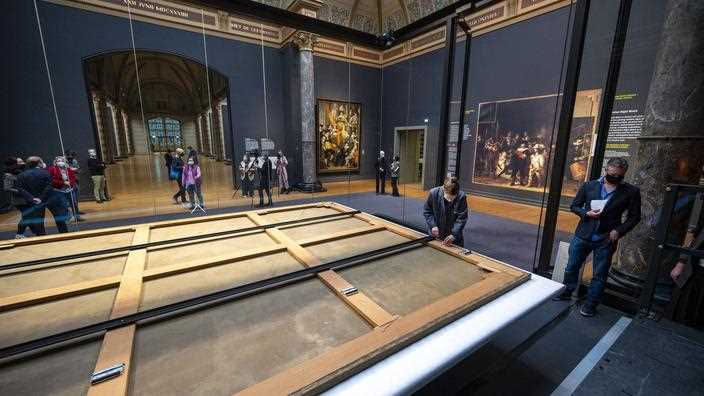A change of frame in the 1970s had subjected the canvas to ripples. A new aluminum structure must restore its good tension.
A new step has been taken. Experts from the Rijksmuseum in Amsterdam began the restoration of the most famous painting by Dutch master Rembrandt on Wednesday, The Night Watch, which will notably remove the ripples that have formed on the canvas since a change of frame in the 1970s.
Read alsoThe Night Watch by Rembrandt restored in public and online
“Over the past two years, we’ve been researching the Night Watch, mapping every fiber, every pigment on the paint“, explained Taco Dibbits, the director of the museum. “And now we will begin the conservation, the restoration“, he announced to AFP. Curators took the museum’s centerpiece off the wall, which measures 3.8 meters high by 4.5 meters wide and weighs 337 kilos, and placed it on a custom-made table. In the next few days they will remove the 1642 canvas from its original frame. “After a while we will see that the current canvas will lose its deformations“, explained to AFP Pieter Roelofs, responsible for painting and sculpture at the museum. The wooden frame will be replaced by an aluminum frame that can “continually maintain a little pressure on the paint so that it cannot puff upsaid Mr. Dibbits. They will then assess whether a complete restoration of the work is necessary.
Thirty experts commissioned
Called “Operation Night Watchthe multimillion-euro restoration project is the most extensive and comprehensive research and restoration work on the masterpiece. About 30 experts have been working for two and a half years in view of visitors to the web, one of the most famous in the world, studying it meticulously with the most advanced imaging techniques and computer technology. During the first phase of the project, the experts notably discovered a sketch under the layers of paint, revealing the “Genesisfrom the Dutch master’s masterpiece. Mr Dibbits said the team had also managed to do “the highest resolution photograph ever taken of a work of art. Now the audience can really zoom into the image, dive into the image and see almost all the pigments“, he greeted.
Read alsothe Standard Bearer, masterpiece by Rembrandt, could leave France after the State package
The Dutchman Rembrandt van Rijn (1606-1669) had received a commission in 1642 from the captain of the bourgeois militia of Amsterdam Frans Banninck Cocq to portray the officers and members of his militia. In nearly four centuries, the painting has experienced many trials. It escaped the Nazis and by 1715 had been trimmed down to be installed in Amsterdam’s Town Hall. The last major restoration dates back more than forty years, after an attack in 1975 by an unbalanced man who slashed it with a knife.
